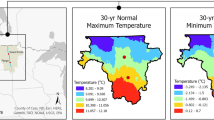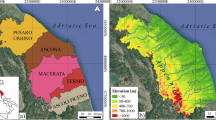Abstract
The aim of this study is to model the daily reference evapotranspiration (ET0) in the Mediterranean region of Algiers, Algeria country, using Adaptive Neuro-fuzzy inference system (ANFIS) and multiple linear regression (MLR) models. Various daily climatic data, i.e. daily mean relative humidity, sunshine duration, maximum, minimum and mean air temperature and wind speed obtained from Dar El Beida weather station, are used as inputs to the ANFIS and MLR models so as to estimate ET0. In order to find the optimal topology of the ANFIS, different architectures were trained and examined and the network with minimum Root Mean Squared Error (RMSE), Mean Absolute Error (MAE) and high Coefficient of Correlation (CC) has been selected as an optimal configuration. A comparison was conducted between the estimates provided by the ANFIS and by MLR. The results showed that ANFIS using the climatic data successfully estimated ET0 and the ANFIS simulated ET0 better than the MLR. Totally 2,193 daily samples were used for training the model, and 730 daily samples for testing and validation of the model. The developed ANFIS model for the ET0 modelling shows good performance with an MAE index in the range of 0.32–0.75, RMSE between 0.41 and 0.75 and the CC in the range of 0.80–0.96, which endows with high performance of predictive ANFIS system to make use for modelling daily reference evapotranspiration (ET0).

Similar content being viewed by others
References
Gocic M., Trajkovic S.: Service-oriented approach for modeling and estimating reference evapotranspiration. Comput. Electron. Agric. 79, 153–158 (2011). doi:10.1016/j.compag.2011.09.001
Tabari, H.; Kisi, O.; Ezani, A.; Talaee, P.H.: SVM, ANFIS, regression and climate based models for reference evapotranspiration modeling using limited climatic data in a semi-arid highland environment. J. Hydrol. 444–445, 78–89 (2012). doi:10.1016/j.jhydrol.2012.04.007
Allen, R.G.; Pereira, L.S.; Raes, D.; Smith, M.: Crop evapotranspiration guidelines for computing crop water requirements, FAO Irrigation and drainage paper No. 56. Food and Agriculture Organization of the United Nations FAO, Rome (1998)
Allen R.G., Clemmens A.J., Burt C.M., Solomon K., O’Halloran T.: Prediction accuracy for project wide evapotranspiration using crop coefficients and reference evapotranspiration. ASCE J. Irrig. Drain. Eng. 131(1), 24–36 (2005). doi:10.1061/(ASCE)0733-9437(2005)131:1(24)
Cammalleri C., Ciraolo G.: A simple method to directly retrieve reference evapotranspiration from geostationary satellite images. Int. J. Appl. Earth Obs. Geoinf. 21, 149–158 (2013). doi:10.1016/j.jag.2012.08.008
Huo Z., Feng S., Kang S., Dai X.: Artificial neural network models for reference evapotranspiration in an arid area of northwest China. J. Arid Environ. 82, 81–90 (2012). doi:10.1016/j.jaridenv.2012.01.016
ASCE Task Committee on Application of Artificial Neural Networks in Hydrology: Artificial neural networks in Hydrology-I: preliminary concepts. ASCE J. Hydrol. Eng. 5(2), 115–123 (2000). doi:10.1061/(ASCE)1084-0699(2000)5:2(115)
ASCE Task Committee on Application of Artificial Neural Networks in Hydrology: Artificial neural networks in Hydrology-II: hydrologic applications. ASCE J. Hydrol. Eng. 5(2), 124–137 (2000). doi:10.1061/(ASCE)1084-0699(2000)5:2(124)
Kisi O.: The potential of different ANN techniques in evapotranspiration modeling. Hydrol. Process. 22, 2449–2460 (2008). doi:10.1002/hyp.6837
Kumar M., Raghuwanshi N.S., Singh R.: Development and validation of GANN model for evapotranspiration estimation. ASCE J. Hydrol. Eng. 14(2), 131–140 (2009). doi:10.1061/(ASCE)1084-0699(2009)14:2(131)
Trajkovic S.: Comparison of radial basis function networks and empirical equations for converting from pan evaporation to reference evapotranspiration. Hydrol. Process. 23, 874–880 (2009). doi:10.1002/hyp.7221
Ozkan C., Kisi O., Akay B.: Neural networks with artificial bee colony algorithm for modeling daily reference evapotranspiration. Irrig. Sci. 29, 431–441 (2011). doi:10.1007/s00271-010-0254-0
Laaboudi A., Mouhouche B., Draoui B.: Neural network approach to reference evapotranspiration modeling from limited climatic data in arid regions. Int. J. Biometeorol. 56, 831–841 (2012). doi:10.1007/s00484-011-0485-7
Ladlani, I.; Houichi, L.; Djemili, L.; Heddam, S.; Belouz, K.: Modeling daily reference evapotranspiration (ET0) in the north of Algeria using generalized regression neural networks (GRNN) and radial basis function neural networks (RBFNN): a comparative study. Meteorol. Atmos. Phys. 118, 163–178 (2012). doi:10.1007/s00703-012-0205-9
Kisi O., Ozturk O.: Adaptive neurofuzzy computing technique for evapotranspiration estimation. ASCE J. Irrig. Drain. Eng. 133(4), 368–379 (2007). doi:10.1061/(ASCE)0733-9437(2007)133:4(368)
Murat C.: Evapotranspiration estimation by two different neuro-fuzzy inference systems. J. Hydrol. 398, 292–302 (2011). doi:10.1016/j.jhydrol.2010.12.030
Kisi O.: Evapotranspiration modeling using a wavelet regression model. Irrig. Sci. 29, 241–252 (2011). doi:10.1007/s00271-010-0232-6
Kisi O., Cimen M.: Evapotranspiration modeling using support vector machine. Hydrol. Sci. J. 54(5), 918–928 (2009). doi:10.1623/hysj.54.5.918
Kim S., Kim H.S.: Neural networks and genetic algorithm approach for nonlinear evaporation and evapotranspiration modeling. J. Hydrol. 351, 299–317 (2008). doi:10.1016/j.jhydrol.2007.12.014
Kisi O.: Fuzzy genetic approach for modeling reference evapotranspiration. ASCE J. Irrig. Drain. Eng. 136(3), 175–183 (2010). doi:10.1061/(ASCE).1943-4774.0000147
Traore, S.; Guven, A.: New algebraic formulations of evapotranspiration extracted from gene-expression programming in the tropical seasonally dry regions of West Africa. Irrig. Sci. (2011). doi:10.1007/s00271-011-0288-y
Shiri, J.; Kisi, O.; Landeras, G.; Lopez, J.J.; Nazemi, A.H.; Stuyt, L.: Daily reference evapotranspiration modeling by using genetic programming approach in the Basque Country (Northern Spain). J. Hydrol. 414– 415, 302–316 (2012). doi:10.1016/j.jhydrol.2011.11.004
Eslamian, S.S.; Gohari, S.A.; Zareian, M.J.; Firoozfar, A.: Estimating Penman–Monteith reference evapotranspiration using artificial neural networks and genetic algorithm: a case study. Arab. J. Sci. Eng. (2012). doi:10.1007/s13369-012-0214-5
Jang J.S.R.: ANFIS: Adaptive network based fuzzy inference system. IEEE Trans. Syst. Man Cybern. 23, 665–683 (1993)
Jang, J.S.R.; Gulley, N.: Fuzzy logic toolbox: reference manual. The MathWorks Inc., Natick (1996)
Atkinson P.M., Tatnall A.: Introduction neural networks in remote sensing. Int. J. Remote Sens. 18, 699–709 (1997). doi:10.1080/014311697218700
Weigend, A.S.; Huberman, B.A.; Rumelhart, D.E.: Predicting sunspots and exchange rates with connectionist networks. In: Casdagli, M.; Eubank, S. (eds.) Nonlinear modeling and forecasting. Proceedings of SFI Studies in the Sciences of Complexity, vol. XII, pp. 395–432. Addison-Wesley, USA (1992)
Prechelt, L.: Early stopping but when? Lecture Notes in Computer Science, Neural Networks: Tricks of the Trade, vol. 1524, pp. 55–69. Springer, Berlin (1998). doi:10.1007/3-540-49430-8_3
Chiu S.: Fuzzy model identification based on cluster estimation. J. Intell. Fuzzy Syst. 2, 267–278 (1994)
Yager R.R., Filev D.P.: Approximate clustering via the mountain method. IEEE Trans. Syst. Man Cybern. 24(8), 1279–1284 (1994)
Heddam S., Bermad A., Dechemi N.: ANFIS-based modelling for coagulant dosage in drinking water treatment plant: a case study. EMAS 184, 1953–1971 (2012). doi:10.1007/s10661-011-2091-x
Jang, J.S.R.; Sun, C.T.; Mizutani, E.: Neuro-fuzzy and soft computing: a computational approach to learning and machine intelligence. Prentice-Hall International (UK) Limited, London (1997)
Author information
Authors and Affiliations
Corresponding author
Rights and permissions
About this article
Cite this article
Ladlani, I., Houichi, L., Djemili, L. et al. Estimation of Daily Reference Evapotranspiration (ET0) in the North of Algeria Using Adaptive Neuro-Fuzzy Inference System (ANFIS) and Multiple Linear Regression (MLR) Models: A Comparative Study. Arab J Sci Eng 39, 5959–5969 (2014). https://doi.org/10.1007/s13369-014-1151-2
Received:
Accepted:
Published:
Issue Date:
DOI: https://doi.org/10.1007/s13369-014-1151-2




